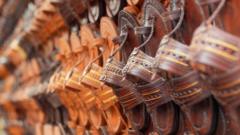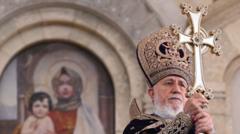The conclave to elect a new leader for the Roman Catholic Church has commenced, with cardinals now engaged in the secretive process set forth by centuries of tradition, employing distinct rituals and items to guide their decision.
Papal Conclave Underway: A Deep Dive into the Voting Rituals

Papal Conclave Underway: A Deep Dive into the Voting Rituals
As cardinals gather to select a new pope, traditional voting objects take center stage in this sacred process.
The conclave, which is held in the iconic Sistine Chapel, follows a well-defined protocol. Cardigans are responsible for casting their votes in secret, ultimately requiring a two-thirds majority to elect the next pope. While the discussions remain hidden from the public's eye, the procedural elements through which the cardinals will navigate their pivotal decision reflect the rich heritage of the Catholic Church.
At the heart of this voting process lie various ceremonial objects as outlined in the Universi Dominici Gregis, a foundational document that outlines the conclave's operational rules. The cardinals will gather around simple wooden tables arranged for optimal assembly and will utilize specific instruments for casting their votes, which include an urn, wooden balls, and stitching materials.
Balloting involves distinct pieces of rectilinear paper, printed with the phrase "Eligo in Summum Pontificem” (meaning “I elect as Supreme Pontiff”). Each cardinal will record their chosen candidate's name on the ballot, which is then deposited into an urn specifically designated for this purpose.
Furthermore, the use of wooden balls facilitates careful tracking of the votes cast. Each ball, inscribed with a number corresponding to each cardinal in attendance, serves as a precautionary measure. During the counting process, an attendant removes a ball for every ballot to ensure that the count is accurate. Should any discrepancies arise, the ballots are incinerated without examination, prompting an immediate re-vote, as stipulated by the regulations of the conclave.
The current conclave continues to draw interest from around the globe, highlighting the intricate traditions of the Catholic Church and its decision-making processes as they chart the future of their faith. As we await the final outcome, it is clear that each action within this historic gathering carries profound significance in the life of the Church.
At the heart of this voting process lie various ceremonial objects as outlined in the Universi Dominici Gregis, a foundational document that outlines the conclave's operational rules. The cardinals will gather around simple wooden tables arranged for optimal assembly and will utilize specific instruments for casting their votes, which include an urn, wooden balls, and stitching materials.
Balloting involves distinct pieces of rectilinear paper, printed with the phrase "Eligo in Summum Pontificem” (meaning “I elect as Supreme Pontiff”). Each cardinal will record their chosen candidate's name on the ballot, which is then deposited into an urn specifically designated for this purpose.
Furthermore, the use of wooden balls facilitates careful tracking of the votes cast. Each ball, inscribed with a number corresponding to each cardinal in attendance, serves as a precautionary measure. During the counting process, an attendant removes a ball for every ballot to ensure that the count is accurate. Should any discrepancies arise, the ballots are incinerated without examination, prompting an immediate re-vote, as stipulated by the regulations of the conclave.
The current conclave continues to draw interest from around the globe, highlighting the intricate traditions of the Catholic Church and its decision-making processes as they chart the future of their faith. As we await the final outcome, it is clear that each action within this historic gathering carries profound significance in the life of the Church.



















